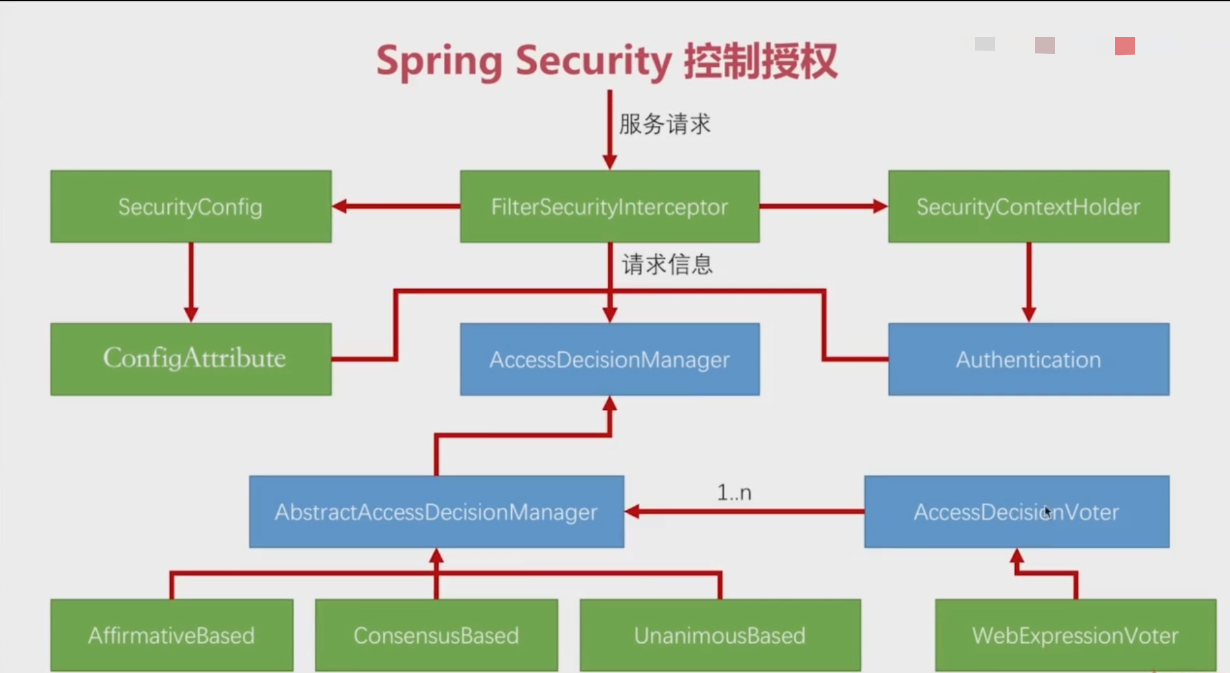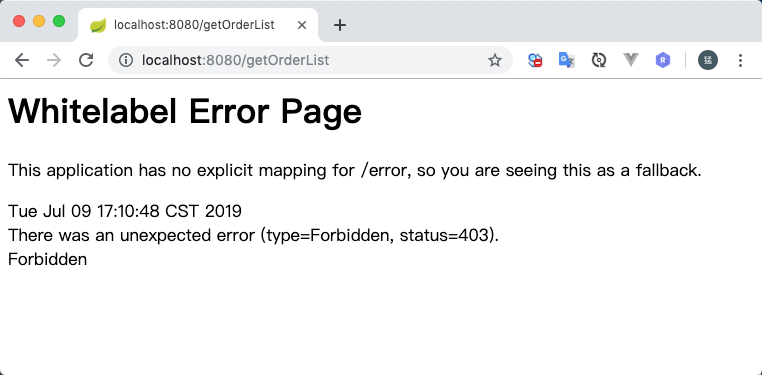一:简介
授权
就是控制url能不能访问。一个请求过来会先经过FilterSecurityInterceptor过滤器拦截,然后调用访问决定管理器AccessDecisionManager,访问决定管理器是通过访问决定投票器AccessDecisionVoter来投票的,如果投票器投通过那么这个url就可以访问,如果投票器投拒绝那么这个url就不能被访问,会抛出一个访问被拒绝的异常。
访问决定投票器AccessDecisionVoter
AccessDecisionVoter接口的实现类是WebExpressionVoter,该投票器通过比较SecurityConfiguration配置的表达式字符串与用户所拥有的权限集合做比较,比较结果如果为true表示投票通过可以访问,如果为false表示投票拒绝不允许访问。
权限表达式
就是跟在http.authorizeRequests().antMatchers("/xxx")后面的方法就是权限表达式,Spring Security会将此权限表达式和UserDetailsService#loadUserByUsername方法回去的User中的authorities权限集合做包含判断,如果包含则返回true,不包含返回false


- permitAll() 不需要登录,所有人都可以访问,永远返回true
- denyAll() 永远返回false,任何情况下都不能访问
- anonymous() 当前用户是anonymous时返回true, 即当前用户没有登录,属于匿名用户
- authenticated() 当前用户不是anonymous时返回true,可以是用户登录的或者使用记住我的都是认证的rememberMe
- fullyAuthenticated() 当前用户既不是anonymous也不是rememberMe时返回true,即是通过登录来认证的
- hasRole(String role) 必须有指定权限才可以访问, Spring Security 会自动对参数值增加一个前缀ROLE_,即如果参数传admin,那么最终会变成"ROLE_admin"
- hasAnyRole(String… roles) 拥有任意一个角色权限就可以访问
- hasAuthority(String authority) 拥有指定的权限时返回true,对于判断Authority的Spring Security会直接判断,不会对参数拼接前缀
- hasAnyAuthority(String… authorities) 拥有任意一个权限就可以访问
- hasIpAddress(String ipaddressExpression) 请求发来的ip地址匹配时返回true
- access(String attribute) attribute可以是其它表达式,也可以通过and 将其它多个表达式连接在一起,如
access("hasRole('ROLE_USER') and hasRole('ROLE_SUPER')"),权限表达式也可以自定义,然后通过access来配置
注意:hasRole和hasAnyRole都会自动对参数拼接前缀"ROLE_", hasAuthority和hasAnyAuthority不会拼接任何前缀。
自己感觉Spring Security中的角色Role和权限Authority的定义并不像我们认为的一个角色对应于多个权限那样的概念,这里的权限好像加上"ROLE_"前缀就变成角色了。
UserDetailsService#loadUserByUsername方法返回的User对象中User(String username, String password, Collection<? extends GrantedAuthority> authorities) 封装的也是权限。
二:代码实现
public interface RbacService {
/** 判断用户有没有权限访问该请求 */
boolean hasPermission(HttpServletRequest request, Authentication authentication);
}
@Component("rbacServiceImpl")
public class RbacServiceImpl implements RbacService {
private AntPathMatcher antPathMatcher = new AntPathMatcher();
@Override
public boolean hasPermission(HttpServletRequest request, Authentication authentication) {
boolean hasPermission = false;
Object principal = authentication.getPrincipal();
if (principal instanceof UserDetails) {
String username = ((UserDetails) principal).getUsername();
// TODO 根据用户名去加载数据库中的用户对应的权限
Set<String> urls = new HashSet<>();
urls.add("/getUserList");
for (String url : urls) {
if (antPathMatcher.match(url, request.getRequestURI())) {
hasPermission = true;
break;
}
}
}
return hasPermission;
}
}
@Configuration
@EnableWebSecurity
public class SecurityConfiguration extends WebSecurityConfigurerAdapter {
@Override
protected void configure(HttpSecurity http) throws Exception {
// 其它任意请求都会调用RbacServiceImpl#hasPermission方法来判断用户有没有权限访问
http.authorizeRequests()
.antMatchers("/login", "/logout", "/regist").permitAll()
.anyRequest().access("@rbacServiceImpl.hasPermission(request, authentication)");
}
}
- 访问http://localhost:8080/login 进行登录
- 登录成功后访问http://localhost:8080/getUserList可以访问
- 访问http://localhost:8080/getOrderList不可以访问


